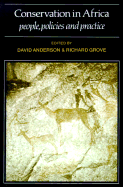Book contents
- Frontmatter
- Contents
- Preface
- List of contributors
- Introduction: The scramble for Eden: past, present and future in African conservation
- Part One Conservation ideologies in Africa
- Part Two Wildlife, Parks and Pastoralist
- Part Three Conservation priorities and rural communities
- Introduction
- 9 Local institutions, tenure and resource management in East Africa
- 10 Conflicting uses for forest resources in the Lower Tana River basin of Kenya
- 11 Environmental degradation, soil conservation and agricultural policies in Sierra Leone, 1895–1984
- 12 Managing the forest: the conservation history of Lembus, Kenya,1904–63
- Part Four Consequences for conservation and development
- Index
12 - Managing the forest: the conservation history of Lembus, Kenya,1904–63
Published online by Cambridge University Press: 04 April 2011
- Frontmatter
- Contents
- Preface
- List of contributors
- Introduction: The scramble for Eden: past, present and future in African conservation
- Part One Conservation ideologies in Africa
- Part Two Wildlife, Parks and Pastoralist
- Part Three Conservation priorities and rural communities
- Introduction
- 9 Local institutions, tenure and resource management in East Africa
- 10 Conflicting uses for forest resources in the Lower Tana River basin of Kenya
- 11 Environmental degradation, soil conservation and agricultural policies in Sierra Leone, 1895–1984
- 12 Managing the forest: the conservation history of Lembus, Kenya,1904–63
- Part Four Consequences for conservation and development
- Index
Summary
In colonial Africa, as elsewhere, conservation has invariably been linked to the dynamics of political life. The colonial state in Africa set down the parameters within which conservation policies were defined. Attitudes to the African environment evolved as the colonial period progressed, and conservation accordingly took on new forms and new roles. Although historians have been able to mark out ‘conservation eras’, to monitor the rise of public awareness of particular issues, and to chart the emergence of technical expertise in the general field of conservation management, they have also stressed the conflicts of interest present at every phase of the evolution of conservation policies (Powell, 1976; McCracken, 1982; Anderson, 1984; Beinart, 1984; Ofcansky, 1984; Helms & Flader, 1985; Anderson & Millington, 1987).This chapter takes up these themes in an examination of the colonial history of conservation in the Lembus Forest of Kenya.
Lembus was awarded to a commercial company for the development of a timber industry while the British conquest of the region was still incomplete. It was one of the largest and most favourable land concessions made to Europeans in Kenya. The subsequent administration of this concession, and the political battles that ensued for control over the management of Lembus, are the central concern of this chapter.
- Type
- Chapter
- Information
- Conservation in AfricaPeoples, Policies and Practice, pp. 249 - 268Publisher: Cambridge University PressPrint publication year: 1988
- 2
- Cited by



